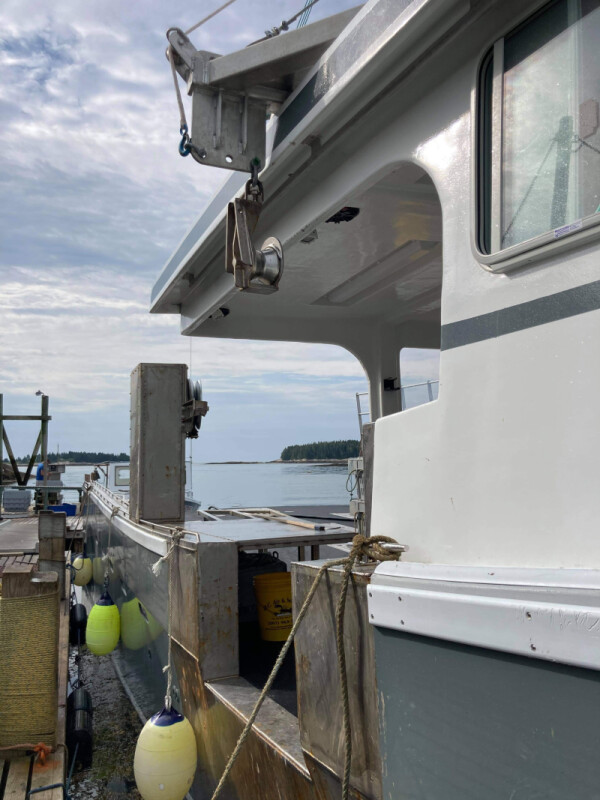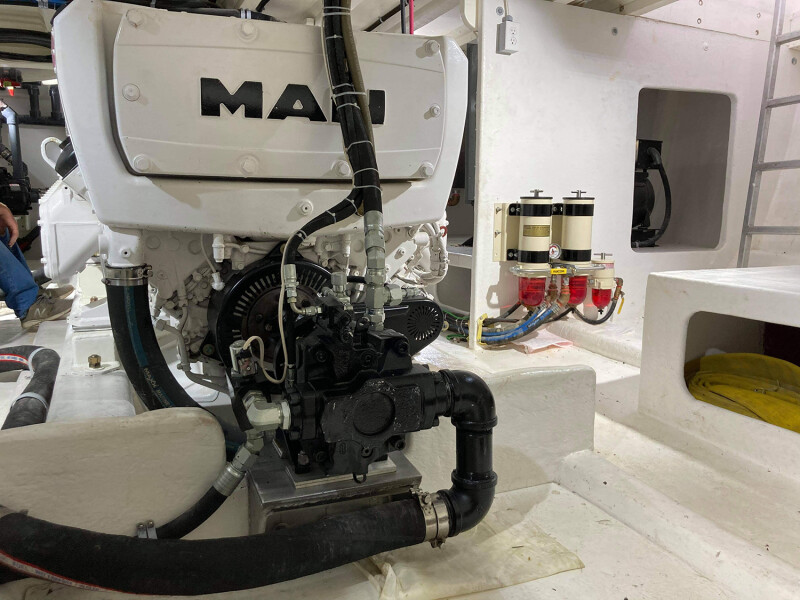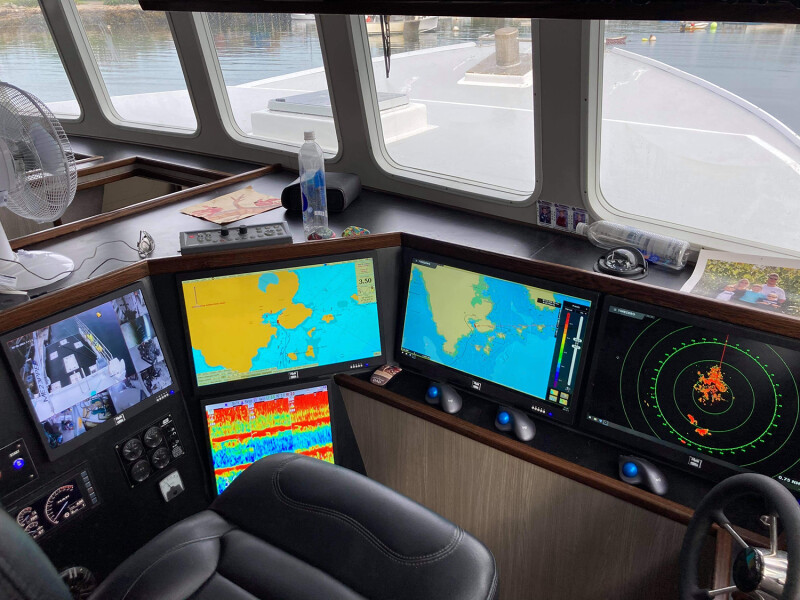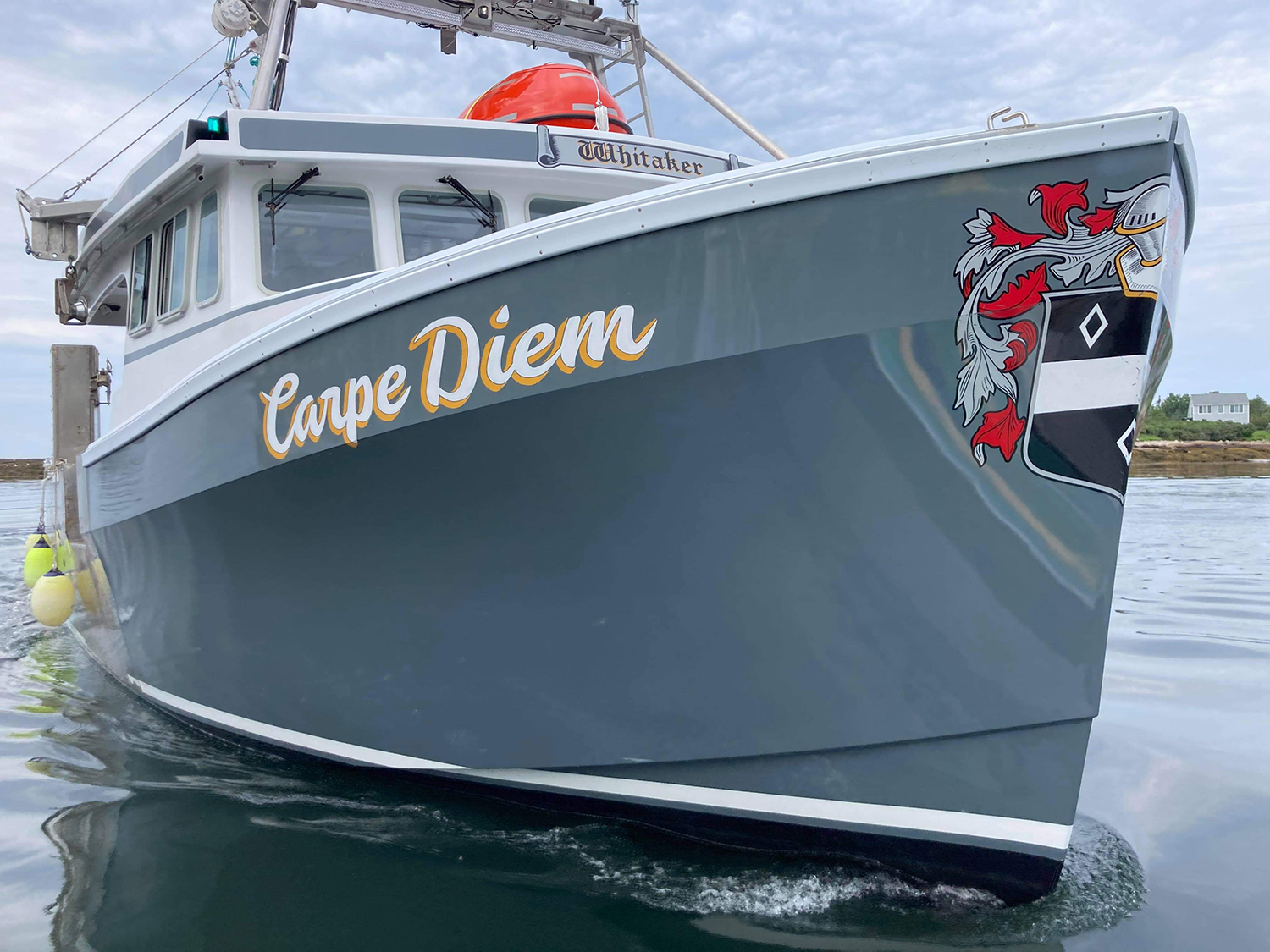Ethan Whitaker’s Carpe Diem is built to fish the deep waters of the Gulf of Maine through the late fall and into winter. The 60-foot Dixon hull, powered with a 1,200-hp MAN, can cruise at 13 knots. Fishing out of Winter Harbor, Maine, the Carpe Diem is designed for overnight trips as far out as Jordan Basin.
“The fall fishing is when we make most of our money,” Whitaker says of his decision to build an offshore-style boat. “If you get a week when the wind’s blowing, it can have a substantial impact on your paycheck.”
So Whitaker decided to build a boat that could follow the lobsters to the limit of Lobster Conservation Management Area 1, about 40 miles offshore. If he wanted to go farther, Whitaker would need to buy an Area 3 permit.
“Later in the season, we fish right out to the line,” says Whitaker. “I’ve always like fishing offshore. I had a 45 Dixon, she’s been a hell of a seaboat, but it was hard to get everything you need on a boat that size. With the 60-foot we can carry the bait and everything we need to haul through everything in a couple of days.” Around 2017, Whitaker started looking at bigger boats and how they were set up.
“I like Dixon. My father has one, and so does my brother. Dixon’s had a two- or three-year waiting list, so I took some time and went over to Grand Manan [New Brunswick] and looked at a 60-foot Dixon there. I went down [to New Hampshire] to look at the Shafmaster boats and how they were set up.”
Jonathan Shafmaster’s offshore boats have become well-known in New England. They have the hauler set up aft of the wheelhouse so crewmen don’t have to lift the traps onto the rail. “It lifts it up, so it just drops onto the table,” says Whitaker.
Whitaker took his collection of ideas over to Gary Dixon at Dixon’s Marine Group in Lower Woods Harbor, Nova Scotia, and the veteran boatbuilder began crafting the Carpe Diem.
Beginning in the early 1990s, Dixon had developed a series of hull designs culminating in the Dixon offshore 50, which he lengthened by 10 feet for Whitaker.

“We started off with a 42-foot Osmond Beal mold that we bought from H&H in Steuben, Maine, in 1993,” says Jeanine Dixon, Gary’s daughter. “We built about 60 hulls with that. Then we wanted something bigger, so we built our 45 mold.” According to Jeanine, they built a model of the 45' x 16' 8" hull and tested it in a flume tank in Halifax.
When they went even bigger with their 50' x 20' mold, Gary pretty much eyeballed it.
“Dad just knows,” Jeanine says of how her father built the company’s latest mold. “I don’t know how he does it.”
At the shop, they popped a 50-foot hull out of that mold and added another 10 feet to the stern and keel.
“It’s different building for Americans,” says Jeanine. “They pay a lot more attention to detail. We had a lot of fun with this one. With the hauler set up the way it was, the cutouts were different.”
Whitaker bought a 1,200-hp V12 MAN, a 2.5:1 Twin Disc gear, and a 20-kW Northern Lights generator from Billings Marine in Stonington, Maine, and trucked it over to Nova Scotia himself. In December of 2020, Whitaker put the 5,000-pound engine, along with the gear and genset, onto a trailer and headed for the Canadian border, which was closed because of the coronavirus pandemic. “We had to have a lot of paperwork,” he says. “But we got across.”

Nonetheless, the border remained a problem during construction. Whitaker recalls that the only time he could get over to see the boat was if he was taking parts. “They were really good at Dixon’s, though,” he says. “They sent me lots of pictures and videos, and we had a lot of calls.”
Dixon’s installed the engine and gear, and lined up the 24.5-foot, 3-inch-diameter Aquamet 22 shaft through a PYI dripless stuffing box to a 41 x 38, four-blade propeller. Whitaker is running two hydraulic pumps off the main engine — one off the front to the engine and one off the gear.
“The one on the front runs my bow thruster and washdown hose, and the one on the reverse gear runs my haulers and lobster tanks,” says Whitaker. “We have two separate systems, so if one were to fail, there’s a couple of valves that I can switch it over.”

Whitaker has two haulers onboard, a 14-inch-diameter Hydro-Slave set up near the steering station, as is common on Maine lobster boats, and a 17-inch-diameter hauler made by Clare Machine Works in Clare, Nova Scotia. The Clare hauler is the workhorse on the vessel. It is set up on a raised housing almost amidship along the starboard rail. Traps come up through a block forward, where Whitaker or a crewman simply slip the gangion out of the block and drop the 85-pound trap onto a table, where they can empty it of lobsters, rebait it and stack it on deck ready to be set out again.
Like many bigger boats working deeper water, Whitaker sets 20-trap trawls anchored on both ends. “We get all our traps from Friendship Trap,” he says. “We use those ones with the liteload runners.” Friendship Trap builds a model of traps with innovative polymer coated steel runners that it says are lighter on deck and heavier in the water.
The Carpe Diem has five live-tanks below deck, with a capacity to hold 96 90-pound crates of lobsters. “We have a fish hold in the center with three tanks forward of it and two aft,” says Whitaker. The hatches are all from Skipper Fisheries in Pubnico, Nova Scotia, and Whitaker points out that he has a simple pumping system to keep the tanks flooded and oxygenated. With a capacity of over 8,000 pounds and average lobster prices around $5 a pound, a full load aboard the Carpe Diem could bring in over $40,000.
“If anything ever happens with lobsters, we could rig up to go scalloping,” says Whitaker. “And she’s big enough, we could go fish dragging.”
During summer, Whitaker takes two deckhands, sternmen in Maine parlance, and will add a third when the lobsters start to run. He set up the Carpe Diem with four bunks in the fo’c’sle, and a galley in the ample wheelhouse.
“We got the bunks down forward, and the table and oven and refrigerator and all that stuff up in the wheelhouse,” says Whitaker. The crew has satellite TV from DirecTV. When offshore, Whitaker uses a Garmin inReach to text home via satellite.
Hines Marine of Woods Harbor put the electronics package aboard the Carpe Diem.
“She’s well equipped,” says Ivan Hines. (See full specs on page 27.)
For radar, Whitaker wanted a 4-kW Furuno open array, a solid-state unit.
“Back-orders what they are, we could only get the 6-kW open array,” says Hines. “So he upgraded for a pretty good deal.”
With the bottom-building technology, probably the most important electronics on the vessel, Whitaker has doubled up with both Olex and TimeZero systems.
“We connected the Olex to a Koden sounder and nav system, and the TimeZero to Furuno,” he says. Whitaker brought the Carpe Diem home to Winter Harbor in April 2021, and she has caught some eyes.
“There’s more videos of her online than you can shake a stick at,” says Hines.
“She sure stands out in the harbor,” says Whitaker, who raced the boat at Bass Harbor Lobster Boat Races in early July, pulling in second place. But she’s first all the way for this Maine lobsterman.







